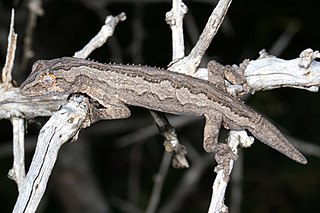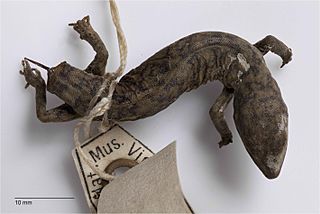
Agamura is a genus of geckos containing two species :

Cyrtopodion is a genus of lizards in the family Gekkonidae (geckos). The genus has 24 described species.

Underwoodisaurus is a small genus of Australian geckos, commonly known with the species Uvidicolus sphyrurus as thick-tailed geckos. The species Underwoodisaurus milii is often called the thick-tailed gecko.

Cyrtodactylus deccanensis, also commonly known as Deccan ground gecko, Günther's Indian gecko, or the banded ground gecko, is a species of gecko found in the northern Western Ghats of India. It has been found from northern Maharashtra, with a habitat range possibly extending to southern Gujarat. Cyrtodactylus albofasciatus was previously considered conspefic with Cyrtodactylus deccanensis but is now accepted as a valid species.
The Cà Ná marbled gecko is a species in the Gekko genus, Gekkonidae family, first found from Southern Vietnam in 2011.

Cyrtodactylus cattienensis, or the Cattien bent-toed gecko, is a gecko endemic to southern Vietnam. It is known from the Đồng Nai and Bà Rịa–Vũng Tàu Provinces. Its type locality is within the Cát Tiên National Park, and the species was named after the park.
Lucasium byrnei, commonly known as the gibber gecko or Byrne's gecko, is a species of small, nocturnal gecko, a lizard in the family Diplodactylidae. The species is endemic to Australia.

Strophurus intermedius, also known commonly as the eastern spiny-tailed gecko or the southern spiny-tailed gecko, is a species of lizard in the family Diplodactylidae. The species is endemic to semi-arid regions of Australia in New South Wales, Northern Territory, South Australia, Victoria and Western Australia, in mallee shrubland and woodland habitats.

The variable fat-tailed gecko or burrow-plug gecko is a Diplodactylid gecko endemic to central and arid inland areas of Australia. Widespread across the continent, the variable fat-tailed is most commonly found in sandy desert habitats dominated by Spinifex grasses. They have also been bred in captivity by zoos and as pets.
Altiphylax mintoni, also known commonly as Minton's thin-toed gecko or the plump swati gecko, is a species of lizard in the family Gekkonidae. The species is endemic to South Asia.
Chondrodactylus fitzsimonsi, also known as Fitzsimons's thick-toed gecko or the button-scaled gecko, is a species of gecko, a lizard in the family Gekkonidae. The species is endemic to southwestern Africa.
Cyrtodactylus condorensis is a species of gecko, a lizard in the family Gekkonidae. The species is endemic to Côn Sơn Island in Vietnam.
Cyrtodactylus hitchi is a species of gecko, a lizard in the family Gekkonidae. The species is endemic Indonesia.

Cyrtopodion agamuroides, also known by the common names Nikolsky's spider gecko, Nikolsky's Iranian gecko, or the Makran spider gecko, is a species of gecko, a lizard in the family Gekkonidae. The species is endemic to eastern Iran and Pakistan.
Kiabi's angular-toed gecko is a species of gecko, a lizard in the family Gekkonidae. The species is endemic to southern Iran.

The Persepolis angular-toed gecko is a species of gecko, a lizard in the family Gekkonidae. The species is endemic to Iran.
Goggia hewitti, known commonly as Hewitt's dwarf leaf-toed gecko, Hewitt's leaf-toed gecko, or Hewitt's pygmy gecko, is a species of gecko, a lizard in the family Gekkonidae. The species is endemic to South Africa.
Parsigecko is a monotypic genus of lizards in the family Gekkonidae. It contains one species, Parsigecko ziaiei, known as Ziaie's Pars-gecko. It is found in southern Iran.
Phyllodactylus reissii, also known commonly as Peters' leaf-toed gecko or the coastal leaf-toed gecko, is a species of lizard in the family Phyllodactylidae. The species is endemic to northwestern South America.
















